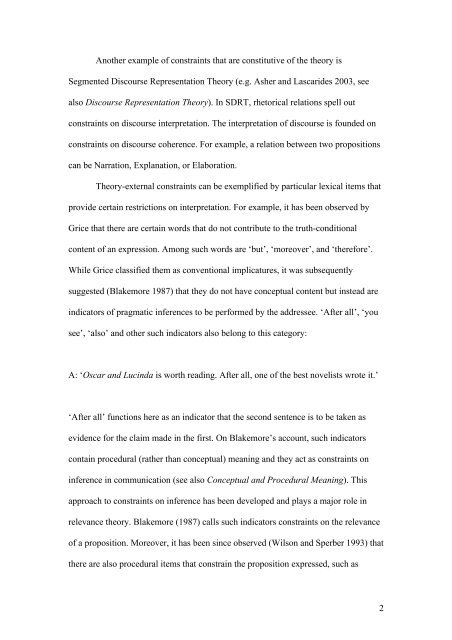Constraint ( in pragmatics) - University of Cambridge
Constraint ( in pragmatics) - University of Cambridge
Constraint ( in pragmatics) - University of Cambridge
You also want an ePaper? Increase the reach of your titles
YUMPU automatically turns print PDFs into web optimized ePapers that Google loves.
Another example <strong>of</strong> constra<strong>in</strong>ts that are constitutive <strong>of</strong> the theory is<br />
Segmented Discourse Representation Theory (e.g. Asher and Lascarides 2003, see<br />
also Discourse Representation Theory). In SDRT, rhetorical relations spell out<br />
constra<strong>in</strong>ts on discourse <strong>in</strong>terpretation. The <strong>in</strong>terpretation <strong>of</strong> discourse is founded on<br />
constra<strong>in</strong>ts on discourse coherence. For example, a relation between two propositions<br />
can be Narration, Explanation, or Elaboration.<br />
Theory-external constra<strong>in</strong>ts can be exemplified by particular lexical items that<br />
provide certa<strong>in</strong> restrictions on <strong>in</strong>terpretation. For example, it has been observed by<br />
Grice that there are certa<strong>in</strong> words that do not contribute to the truth-conditional<br />
content <strong>of</strong> an expression. Among such words are ‘but’, ‘moreover’, and ‘therefore’.<br />
While Grice classified them as conventional implicatures, it was subsequently<br />
suggested (Blakemore 1987) that they do not have conceptual content but <strong>in</strong>stead are<br />
<strong>in</strong>dicators <strong>of</strong> pragmatic <strong>in</strong>ferences to be performed by the addressee. ‘After all’, ‘you<br />
see’, ‘also’ and other such <strong>in</strong>dicators also belong to this category:<br />
A: ‘Oscar and Luc<strong>in</strong>da is worth read<strong>in</strong>g. After all, one <strong>of</strong> the best novelists wrote it.’<br />
‘After all’ functions here as an <strong>in</strong>dicator that the second sentence is to be taken as<br />
evidence for the claim made <strong>in</strong> the first. On Blakemore’s account, such <strong>in</strong>dicators<br />
conta<strong>in</strong> procedural (rather than conceptual) mean<strong>in</strong>g and they act as constra<strong>in</strong>ts on<br />
<strong>in</strong>ference <strong>in</strong> communication (see also Conceptual and Procedural Mean<strong>in</strong>g). This<br />
approach to constra<strong>in</strong>ts on <strong>in</strong>ference has been developed and plays a major role <strong>in</strong><br />
relevance theory. Blakemore (1987) calls such <strong>in</strong>dicators constra<strong>in</strong>ts on the relevance<br />
<strong>of</strong> a proposition. Moreover, it has been s<strong>in</strong>ce observed (Wilson and Sperber 1993) that<br />
there are also procedural items that constra<strong>in</strong> the proposition expressed, such as<br />
2
















